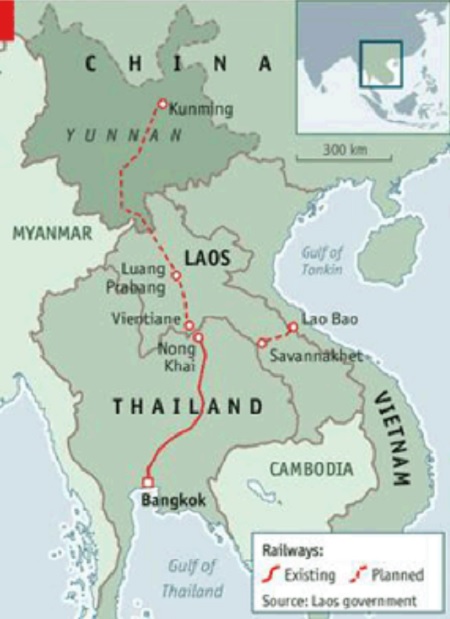The Laos-China railway will provide significant momentum for the development of the Boten-Mohan border economic cooperation zone, experts have noted.
The railroad, a key project under China’s Belt and Road initiative, will link the Mohan-Boten border crossing in northern Laos to Vientiane, over a distance of 427 kilometres.
Experts are optimistic that the border economic cooperation zone could become a regional hub for trade, investment and tourism once the almost-US$6 -billion railway is complete.
Chinese Premier Li Keqiang told his visiting Lao counterpart Thongloun Sisoulith in Beijing last week that China is willing to work with Laos to push forward the development of the railway and economic cooperation zone.
The two premiers witnessed the signing of two cooperative documents on border trade and the economic cooperative zone.
Mr Thongloun said he was committed to building the railway as it was of great importance to Laos in transforming the land-locked country into a land link within the region.
The political commitment by the two countries aims to ensure that the two projects progress as planned.
Located at the Mohan Border Port, which is China’s gateway to Laos and provides access to Southeast Asia’s most convenient land route, the economic zone has significant investment potential.
The Boten Specific Economic Zone is located in Luang Namtha province and is accessible by Road No. R3.
The zone is being developed by two Chinese companies – Yunnan Hai Cheng Industrial Group Stock Co., Ltd. and Hong Kong Fuk Hing Travel Entertainment Group Ltd.
Vice President of the zone’s management board, Mr Vonekham Phetthavong, told Vientiane Times recently that the developers are concentrating on infrastructure development and providing facilities to accommodate the investment and tourism sectors.
We are building two hotels which could be as high as 15 storeys, to accommodate tourists, he said.
About 1,000 tourists visit the zone each month. Our activities include trekking in forests, watching cultural performances and other activities.
The US$500 million project covers 1,640 hectares and comes with a concession period of 99 years.
The Chinese developers will focus on four large-scale projects: a duty free centre, bus station complex, warehousing and a resort featuring a large natural marsh, hotel, meeting hall and leisure areas.
Mr Vonekham said many more investors and visitors will head to northern Laos once the economic cooperation zone in the Boten-Mohan border area is fully operational.
However, so far the project has not progressed as anticipated. As of August this year, only a little over US$50 million had been spent on the Boten Specific Economic Zone by the new Chinese developers.
The China-Laos railway is a vital part of the trans-Asia railway network that will link China with ASEAN nations to boost economic cooperation and people-to-people ties.
Construction is expected to start simultaneously in a number of provinces this month, with the whole railway scheduled for completion over the next five years.
Source: Vientiane Times



